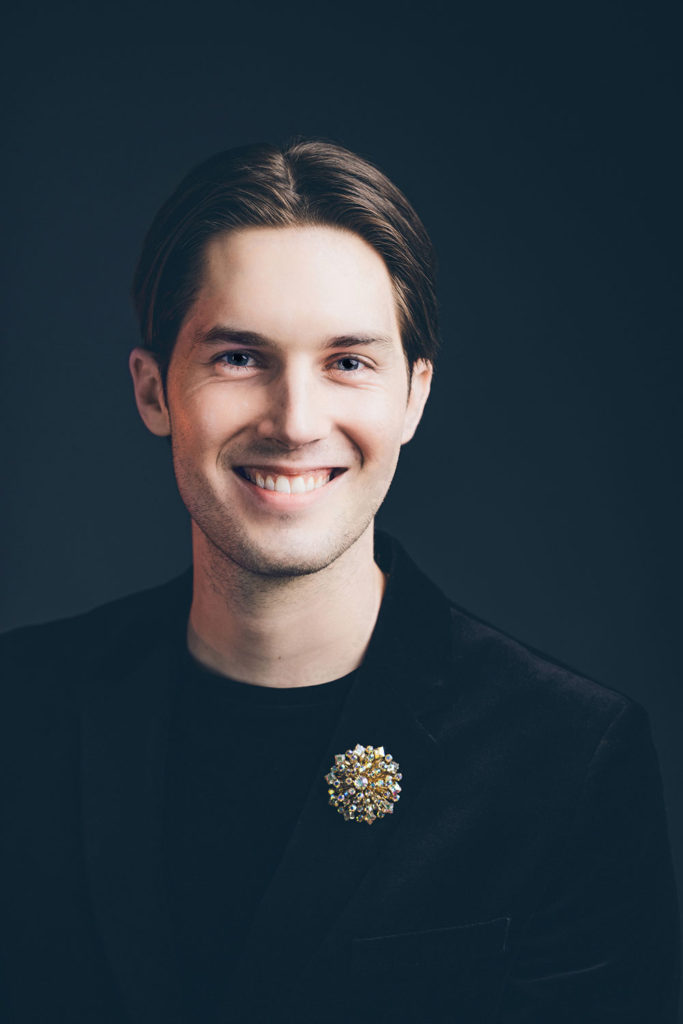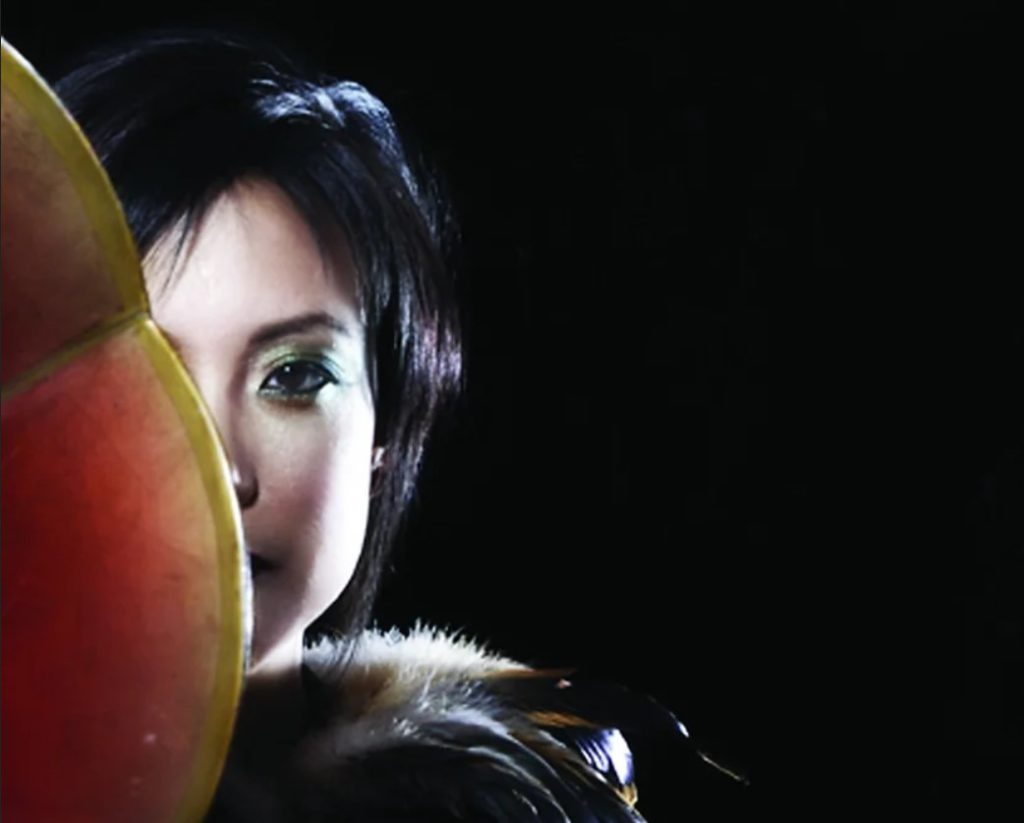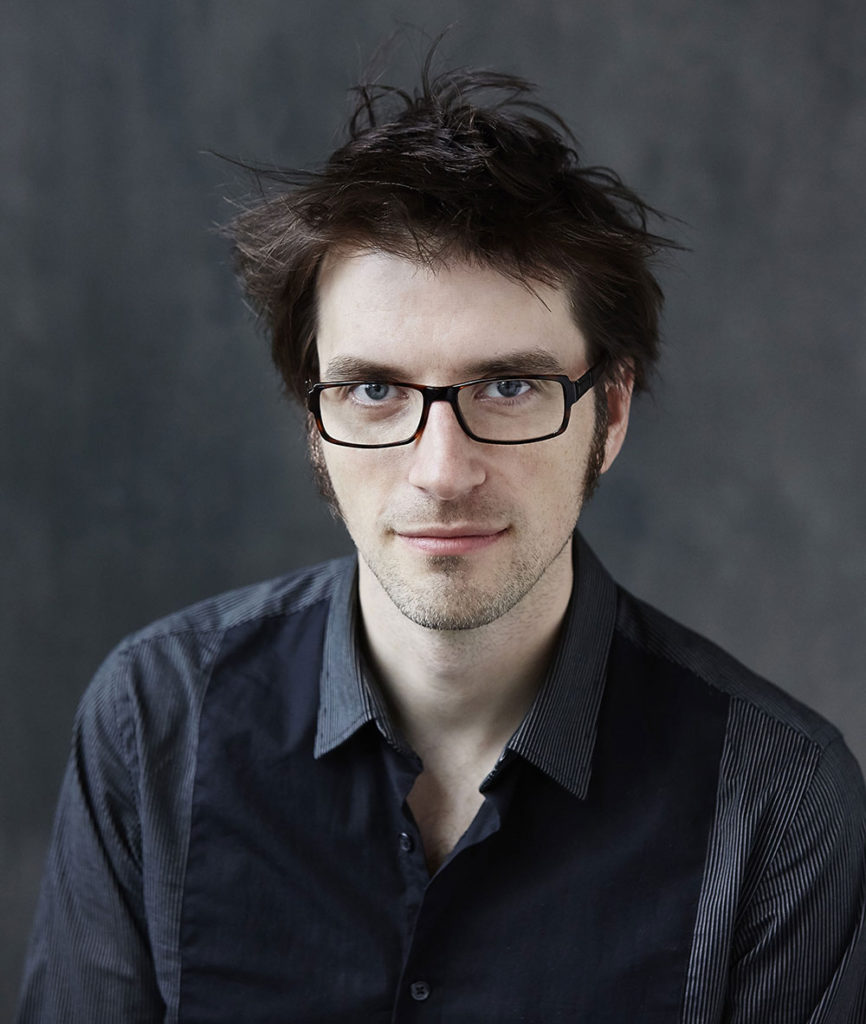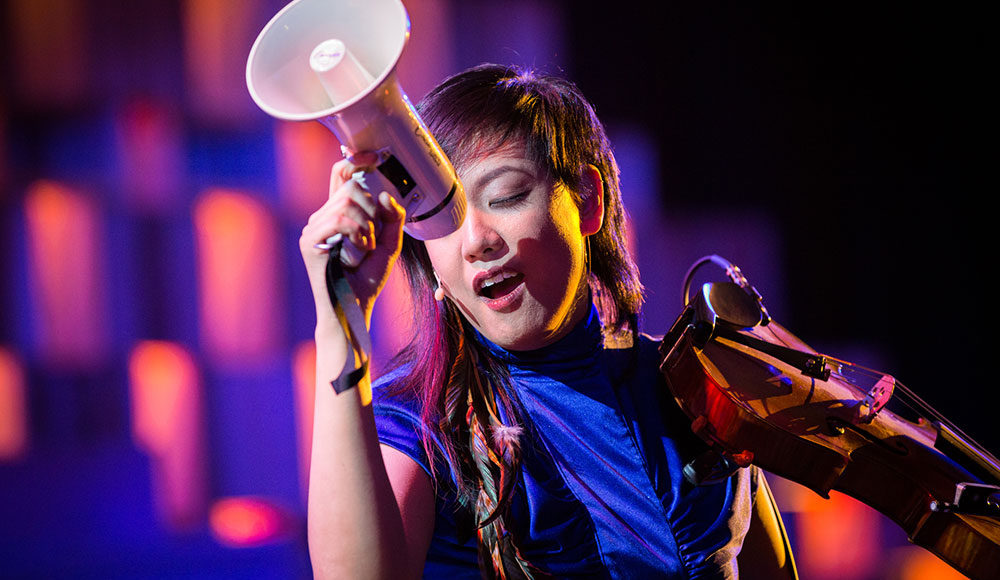Any minute now the Cabrillo Festival of Contemporary Music will start filling the Civic Auditorium with what Music Director Cristian Măcelaru calls “tomorrow’s music.” Always impossible to characterize, this festival is known for chance-taking surprises, for music you’ve never heard of.
This season, Music as Movement, strongly highlights the journeys of tribes, individuals, nations transmuted into world premieres by young living composers. The theme of movement will also play itself out through an experimental commission called Creative Lab.
Embodying the spirit of this season, the inaugural Creative Lab project, Parhelion, will play with acoustical architecture, special visual design interwoven with vocals and heightened sonics.
I spoke with Riley Nicholson, the festival’s new executive director, about his expectations for this season, and also with composer Bora Yoon and video programmer Joshue Ott about their immersive collaboration, Parhelion.
THE EXECUTIVE DIRECTOR

Riley Nicholson, well-known as a pianist and composer in the Bay Area, has most recently led the Symphony of Northwest Arkansas in expanding its offerings in living music, before being tapped last autumn as our festival’s executive director.
Can you tell us a little about Creative Lab?
Riley Nicholson: The Creative Lab is a new commission, but something more. With a typical commission, composers deliver a score, they maybe have a conversation with [music director] Cristi, and then they collaborate during rehearsals, which is beautiful and wonderful, but we wanted to take it a step further. We wanted to give the composer even more creative and curatorial control over the entire experience, the latitude to design an entire experience and not just notes on a page. In a way, this is beyond the orchestra.
Bora Yoon is really interested in technology and multimedia and creating an experience through production design, and we told her, here’s the orchestra, here’s the hall, it’s your play space. So, for example, at one point Bora’s placing some of the musicians around the entire perimeter of the venue. There’s a strong spatial aspect to this piece. And her producer Annie March will be working with our production team to think about lighting design, and there might be some props and projections and things like that.
What fills most of your time as incoming executive director?
Nicholson: It’s a little bit of everything, especially wearing many hats, which is often the case with nonprofits. So it’s very, very collaborative. I have my hands in all the different buckets, and that’s good, because it’s my job to be able to zoom in and zoom out. I need to be able to see the big picture, see where we’re headed, see maybe threats in the future, opportunities in the future, but also be able to manage the mechanics of the everyday administrative operations and subtly shift those over time to get us where we need to go.
That’s kind of the most exciting and most challenging thing, being able to do the little pieces and get your hands dirty, so to speak, but also work collaboratively with the music director and the board to really think big picture about the organization. And of course a big piece of that is fundraising. Fine tuning this season was a great test run of our collaborative relationship, finding ways to craft the season together. But it’s still very much Cristi’s vision.
THE COMPOSER

Korean-American composer and sound artist Bora Yoon brings her commissioned work to the Aug. 10 concert: Parhelion, an immersive sound experience work in collaboration with Joshue Ott’s Interval Studios and Visual Endeavors for multimedia and visual design.
Talk a little about Creative Lab and what kind of parameters you were given for this commission.
Bora Yoon: I’m really honored to be asked to be the first composer in this new initiative. And I think it’s also a really exciting time for symphonic new music. I think what the Creative Lab is doing in a post pandemic world is re-envisioning how we see orchestral music moving into the 21st century. It was very much an open invitation to bring my exploratory and kind of adventurous approach to soundscape work. I have worked on theater scores and dance scores. I don’t necessarily always blend them together. But it’s special about when you can bring two seemingly disparate fields together. Everybody shudders when you say electronics, But I also think that it can be tastefully done. Not using electronics for what the orchestra can do, but for the things that are irreplicable in the orchestra, like the sounds of wind or the sounds of water, environmental sounds. Knowing how to balance the acoustic ocean of sound that the orchestra is.
It’s a challenge scoring for orchestra as well as found, manipulated and digital sound.
Yoon: I understand the challenge. I actually feel like that’s maybe why they trusted me because I do have a vast musical language that goes beyond the orchestral world, but I do know the protocols of the orchestral world, how it works. But to be asked to actually synthesize them all skillfully and to make something new was a real challenge.
How did you work with the Civic’s acoustics?
Yoon: This work was proposed two years ago. Last year a piece of mine was performed at the Civic, so I knew the acoustics. And it was great to get to know the festival, understand the space, and the culture of the festival. I was able to compose the work knowing all those things in advance. It was really intelligently planned by Ellen Primack [the festival’s former, longtime executive director] that way. I got to hear the same conductor and the same ensemble. And knew that all these players are down with doing weird things. That’s not always the case for orchestra. But the Cabrillo orchestra players are on the composer’s side. They’re totally down to try their adventurous things.
You already have a working relationship with Joshue Ott.
Yoon: Yes, he’s a longtime collaborator, maybe 10 years of working on projects. So I take care of the sound realm and he takes care of the visual realm, with a beautiful custom software that he created himself, called Super Draw. It works in real time, and I remember seeing it for the first time and my jaw just dropped. It’s gorgeous.
He and I have toured so we already have a working language together, sound worlds to visual worlds. Whenever I compose anything, I truly do think of music very visually. So whether it’s the image of the man, the image of the place that I’m painting, or whether it’s a narrative, there’s always some kind of visual component. This is an orchestral commission, but I think of it as a kind of a show sequence with many different vignettes, significant and small vignettes, or scenes and interludes.
What can we expect with Parhelion?
Yoon: The beginning is kind of an acoustic outer space, kind of soundscape of sirening sounds or Doppler effects of sound. There’s all these different kind of metals that pulsate at different frequencies. It starts with this cosmos that’s very open, not necessarily metered. A lot of the instruments that have belled horns, like trumpet and clarinet and my voice that’s going to come through the microphone, will all be in Doppler effect so the audience is surrounded by acoustical design. We’ll be using the balcony spaces of the Civic to kind of lighthouse the sound, moving from left to right. Then there’s these kind of brass fanfares that happen throughout the piece, initially as a foreshadowing of what’s coming. Then we’re going to get much more granular. So we go from light that’s very pulsating and very distant and aerial to string harmonics and crystalline metal sounds, bells, maybe the sound of writing. The orchestra is going to do this collective breathing. A lot of white sounds.
I’m using Josh’s visuals as a way to jam with the orchestra. The plan is that the orchestra will continue playing through a particular composed movement that’s been designed so that the video collaborator can follow the movements of Cristi’s baton, follow the bowings of the violin sections to generate visual graphics. They will be responsive to each other, orchestra and visual design.
And there will be audience engagement in this performance, in the sound of things like the rustling of newspapers, wings, bird calls, to spatialize the sound field. We’ll have little LED diodes so it will look like a vast field of stars. These are all ideas that we’re still talking about in production meetings, but the vision is to get people to be part of the atmospheric experience.
THE DESIGNER

Joshue Ott, of Interval Studios and Visual Endeavors is light designer and programmer, and collaborator for Yora Boon’s Parhelion. Ott is a New York-based software designer specializing in time-based interactive experiences.
What got you into a light design?
Joshue Ott: I’m a creative technologist as well as a visual artist. I went to art school and studied computer graphics. My interest was always in abstraction and abstract forms. And I just started making this visual software. I started going to these weird jam sessions in New York City in the early 2000s where everybody would bring all of their technical toys and jam out together. That was very inspiring. And I got inspired to make my own software. And that piece of software became something that was the source of many, many collaborations, one of which was with Bora. I started making visuals for her. Bora and I have a really nice working relationship, where it’s almost like we’re completing each other’s creative sentences.
Does your work respond to acoustic prompts?
Ott: Actually it doesn’t. It’s not actually responding to any audio or anything like that. It’s completely controlled by a human being. I built it to be an instrument like a violin or a guitar. And my goal was to make it as responsive and as malleable, as the guitar or as a violin. Those instruments are capable of a very wide range of incredible sounds and rhythms. So I wanted to do that with visuals and a computer and abstract art. For Creative Lab I’ve designed the instrument with all these visuals, and I’m sending a good friend of mine, Nathan Wheeler, who is going to play this instrument.
How is it not a light show? Light shows were freestanding, abstract works of art made of oil, water, and pigment forming the colorful backdrop rock bands. In what way is this different or the same?
Ott: I think it’s actually quite similar. I think that’s a very good description of what’s happening, more than just a VJ set. But I think the way it’s different is that I have so much control of the software and the choices that we make can be more extreme. And if it’s doing its job, if we’re at our best, we are creating something that is sort of beyond sound or beyond visuals. It is intertwined in a way that you can’t really take it apart. And at its best, it’s giving the audience more information and more to think about, and a new understanding of what you’re hearing and experiencing.
So the other difference is that my software, SuperDraw, also produces audio. Some of the sections of Parhelion will have audio actually generated by my software that blends with the orchestra. I’ve been doing this for 20 years like I said, it’s changing all the time. I’m actually working on a new version of the software that may make it to this piece, so I’m really excited about that.
It’s all in that same magical place where it goes beyond what a projector does or what theater lighting does. It’s sort of something new and volumetric that exists outside the space that we’re in. My goal is to bring this ethereal other space into existence through these pieces, through this software. ■













